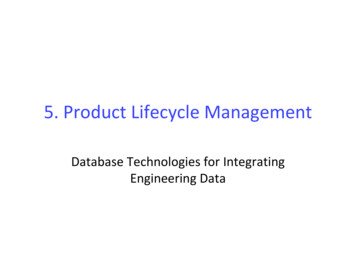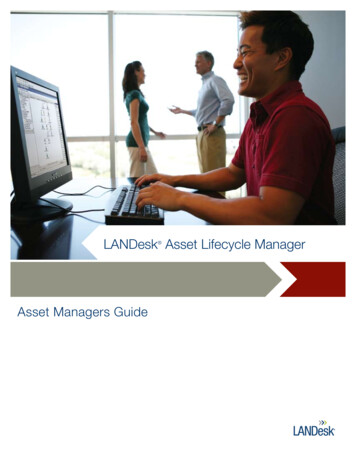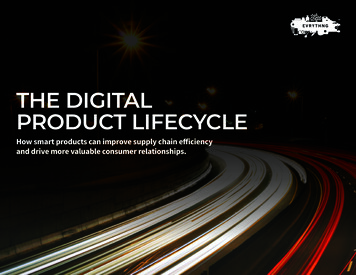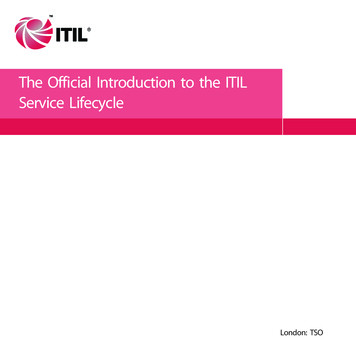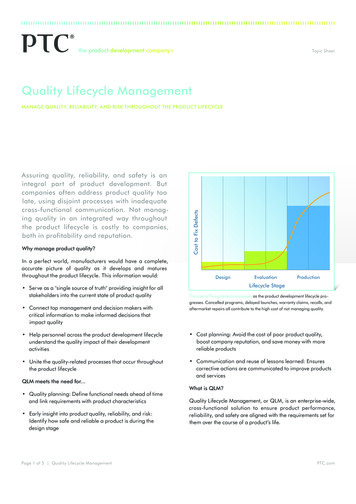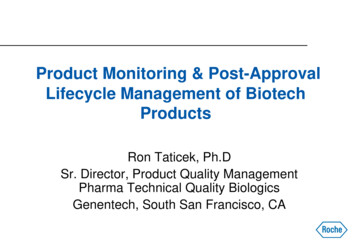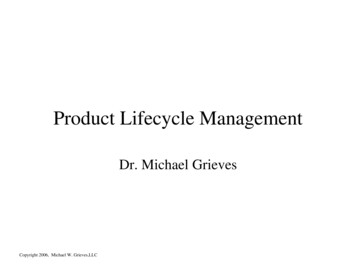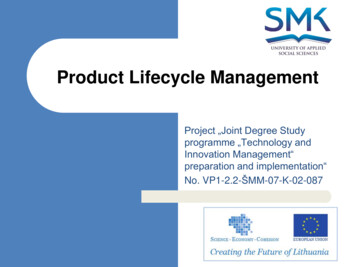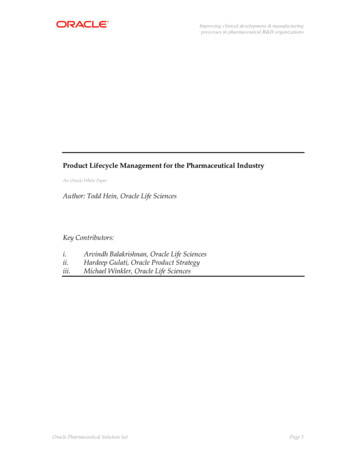
Transcription
Improving clinical development & manufacturingprocesses in pharmaceutical R&D organizationsProduct Lifecycle Management for the Pharmaceutical IndustryAn Oracle White PaperAuthor: Todd Hein, Oracle Life SciencesKey Contributors:i.ii.iii.Arvindh Balakrishnan, Oracle Life SciencesHardeep Gulati, Oracle Product StrategyMichael Winkler, Oracle Life SciencesOracle Pharmaceutical Solution SetPage 1
Improving clinical development & manufacturingprocesses in pharmaceutical R&D organizationsIntroduction:In recent years the pharmaceutical industry has faced declining R&D productivity, a rapidlychanging healthcare landscape and fierce competition from generics resulting in lower growthand profit margins. Historically, drug development focused on clinical trials management andoutcomes. Now however, the industry is looking at more holistic approaches to improveprocesses of bring new products to market that can accelerate product development whilelowering operational costs. This is challenging because of the complex value chain and businessprocesses required in this highly regulated environment. Additionally, it has proven difficult forthe industry to effectively adapt as many pharmaceutical companies are simply not optimized forcross functional collaboration which is so desperately needed to support these changing marketconditions.One meaningful and holistic approach to today’s current challenges within the pharmaceuticalindustry is to focus on Product Lifecycle Management (PLM), which is a business transformationapproach to manage products and related information across the enterprise. In recent years PLMhas provided many pharmaceutical organizations with the ability to increase their ability to getproducts to market quicker, ensure greater regulatory compliance and efficiencies while reducingdevelopment costs.This article identifies some key business metrics that benchmark a company’s performance andkey strategic business processes required to improve R&D performance through a PLM businesstransformation approach.Management of the Lab to Launch ProcessThe Pharmaceuticals Industry faces three key challenges today:1. Complex Drug Development Process2. Large Gaps Between R&D Operational Performance and Strategic Importance3. Difficulty in managing Clinical Trial InventoriesComplex Drug Development ProcessThe drug development process is complex, consisting of many interrelated business activitiesand functional constituents participating in the “Lab to Launch” of any given product (Figure1).Figure 1 “Lab to Launch” ContinuumReal-time synchronization of these activities is critical for achieving improved performance andregulatory compliance in the R&D pipeline. Effective management, knowledge re-use andOracle Pharmaceutical Solution SetPage 2
Improving clinical development & manufacturingprocesses in pharmaceutical R&D organizationsaccurate monitoring across these core activities requires automation. Automating will also enablestandardization based on best practices and consolidation of content across the R&D pipeline,forming a compliant dataset for Quality by Design (QbD) based submissions.Large Gap Between R&D Operational Performance and Strategic ImportanceTo address the development process, the pharmaceutical industry has identified key R&Dfunctions that are considered important in optimizing R&D pipeline effectiveness (AMR). Thisresearch indicates significant gaps exist between R&D operational performance and strategicimportance resulting in the industry operating at less than 50% effectiveness (Figure 2).Figure 2 R&D Performance GapsFinally, some of the key influencers that have commonly impacted profitability, risk and growthcan be traced back to three fundamental issues within the industry itself: Increasing internal and external complexity in managing the entire product lifecyclefrom product inception to phase out due to the simple fact that many pharmaceuticalorganizations suffer from silos of information across the different functional areas. In thecase of R&D organizations this is typically based on therapeutic areas whereby crossfunctional information flow is either lacking or non-existent. No single data source for products and related information due to a variety of differentdata sources and lack of collaboration across the organization. This often results indisparate, redundant and in worst cases inaccurate product information depending onfunctional area. Gap Between R&D and Commercialization: Historically R&D processes have beenlargely viewed as independent of product launch and subsequent commercializationefforts within the industry thus resulting in a fundamental gap for coordinated andtransparent collaboration.Hard to Manage Clinical Trial InventoriesA critical element of the drug development process is the production and management of theclinical trial inventory. Effective management of the “chain of custody” of this initial clinicalinventory is difficult and becomes more complex as Contract Manufacturing Organizations(CMOs) and other external partners are utilized in this strategic process. Traditional inventoryautomation tools such as ERP or MES systems do not provide the flexibility needed at this stageof R&D production. Instead manual disjointed processes supported with desktop tools such asOracle Pharmaceutical Solution SetPage 3
Improving clinical development & manufacturingprocesses in pharmaceutical R&D organizationsExcel are often utilized resulting in unnecessary process and coordination complexity. Lack ofprecise coordination of the clinical trial inventory within the trial management plan is disruptive,adding considerable cost and time to this phase of product development (AMR). Consequently,key clinical supplies metrics routinely result in less than 25% of their targeted performanceobjectives (Figure 3).Figure 3 Clinical Supplies “Chain of Custody”This combination of poor execution of the R&D pipeline and compromised production efficiencyof the initial clinical supply process results in inadequate R&D results (AMR). Industry metricsbased on project timeline performance, project cost, expected financial margin, and market sharecapture, show that approximately only 1 in 3 programs achieve their expected performancetargets (Figure 4).Figure 4 Current R&D Pipeline PerformancesTransforming the Pharmaceutical IndustryAn Opportunity to Improve R&DWhile there are significant challenges within the pharmaceutical industry, opportunities exist inthis increasingly competitive landscape for innovative companies looking for ways to transformtheir business that lead to profitability and growth. Companies that successfully manage thetransformation process to address these challenges will realize improved business performanceOracle Pharmaceutical Solution SetPage 4
Improving clinical development & manufacturingprocesses in pharmaceutical R&D organizationsand differentiation in the market place as a result. As companies look to speed up the process bywhich new products are brought through the development pipeline to commercialization whilesupporting new therapeutic areas, a business transformation focused on cross functionalcollaboration whereby product knowledge can be uniformly leveraged will result in bothproductivity and revenue gains. It is also important to appreciate that even small incrementalimprovements can produce significant results in both revenue growth and margin (Oraclecustomer business cases). For example, for every day a company can reduce from the overalldevelopment cycle, they can realize significant reductions in cost and provide significant returnsin both profitability and margins (Figure 5).Figure 5 R&D Pipeline Potential ImprovementsAchieving R&D ImprovementTo achieve this, companies should apply the mantra of “think big - start small - scale fast” for anyinitiative related to improving development and manufacturing of clinical supplies. This willallow the enterprise to prioritize on a few key initiatives, standardize on those processes, andexpand through a process of continuous improvement across the development organization.Further, the initiative should have executive sponsorship across the entire organization, as thisshould be viewed as a business transformation and not a departmental project.Some common characteristics have been identified for successful transformation initiatives. First,it is important to model the current R&D process and how it impacts clinical supplies.Understanding the functional requirements of each of the “swim lanes” and the inter-relationshipacross these constituents will define challenging areas to focus on for initiating this activity. Atemplate of common drug development activities and constituents supporting this activityprovides a starting point for many organizations beginning a business transformation process.(Figure 6)Oracle Pharmaceutical Solution SetPage 5
Improving clinical development & manufacturingprocesses in pharmaceutical R&D organizationsFigure 6 R&D Pipeline Cross Function ParticipantsSecond, with a common development model outlined for the enterprise and key challengesidentified, a business case can be developed to prioritize on which initiatives are most critical toaddress. A business case also helps justify the investment and provides metrics to measurerealized business improvements such as ROI and operational performance for each specificinitiative.Third, for the initiatives that have been prioritized by the development challenges and justifiedwith a business case, specific transformation requirements need to be defined. To definerequirements, a review of the current IT landscape supporting these activities and the contentmanaged in various systems must be compiled. This activity will establish base line processes toimprove and help define requirements, plus define historical content that needs to bemigrated/integrated to support the transformation.The final step is to define a deployment plan to manage the transformation of these keyobjectives. It is critical that functional constituents who own these business processes aremembers of the deployment team in addition to executive sponsorship across the organization.With a well-represented cross-functional team supporting the transformation, concrete objectiveswill be defined and expectations clearly outlined for success. This approach also provides thefoundation for “think big - start small – scale fast” for ongoing enterprise transformation.Strategic business processes required to support transformation7 Ways to Transform Your BusinessSeveral companies are actively pursuing transformation initiates to address these challenges.Benchmarking of these initiatives helps identify common business processes required to enablethis transformation. Based on input from 15 leading pharmaceutical companies who are membersof the Oracle Pharmaceutical Strategic Council, seven common enabling elements have beenidentified to support this transformation (Figure 7).Oracle Pharmaceutical Solution SetPage 6
Improving clinical development & manufacturingprocesses in pharmaceutical R&D organizationsFigure 7 Key transformation ElementsAn operational review of each of these elements can be used to determine what functionalrequirements need to be deployed to support the transformation roadmap.The complexity of individual drug development programs is further complicated as there aretypically multiple programs occurring simultaneously in the R&D pipeline at any given time.Traditional drug development program management has focused on general program metricssuch as schedule, and cost performance. To improve drug development execution, programmanagement that synchronizes cross-functional collaboration and archiving of critical programdeliverables is required. Integration of the decisions and approvals of these deliverables providethe regulatory evidence needed to confidently advance the drug development process througheach phase. Management of each program and required deliverable evident in one system canalso enable standardization of best practices to improve pipeline performance.With the volume of program deliverables and regulatory evidence required in the developmentprocess ever increasing, a structured drug development archive is needed to effectively manageall of the associated content. This highly iterative development record must be automated tocapture historical developmental information to support product claims and regulatory audits.Creating a structured archive for each individual design dossier in one unified system can alsofacilitate re-use of the Common Technical Documents (CTD).Oracle Pharmaceutical Solution SetPage 7
Improving clinical development & manufacturingprocesses in pharmaceutical R&D organizationsClinical trial management is a pivotal phase in the drug development process that has becomemore complicated with global and adaptive trials. As companies look for ways to reduce costswhile significantly increasing profitability, externalization of clinical trials to CROs for examplehas become increasingly common and impacts everything from pre-clinical to post marketingresearch. The supply chain for clinical trials has also become increasing complex with multiplemanufacturing sites and CMOs engaged in supporting the scale up for the required clinicalinventory. For all supplies dispensed to each clinical site, a complete lot history of the campaignsproducing the product must be archived. Synchronizing the approved manufacturing evidenceof the clinical supplies with trial activity is required for clinical trial integrity to be maintained.The production of drug product is highly iterative and controls must be established for each lotfrom scale-up through commercialization of the final approved product. Effective scale-up ofdrug production requires collaboration across many interrelated activities and dependences. Anenterprise solution that enables the analysis of the drug product value chain including suppliers,materials, equipment, and processes will not only provide individual lot control but also facilitatethe scale-up to commercial drug production volumes.Quality and risk management continues to be a challenge creating significant business impactwhen deficiencies are indentified during regulatory audits. Furthermore, with the industriestransformation to QbD practices for product development, the need for an Enterprise QualityManagement (EQM) solution is further justified. An effective EQM solution requires theintegration and management of quality beginning at product development throughcommercialization. Early awareness of quality events and immediately assessing the impactacross the enterprise will provide the foundation to leverage quality management resulting inimproved business performance.The integration of packaging, labeling and associated marketing collateral into the drugdevelopment process provides a significant business opportunity in the pharmaceutical industry.Often the creation of these assets is deferred until late in the drug development cycle creatingdelays in market launch and increased cost. This disconnect from the drug development evidencealso creates the potential for misleading off-label claims that can be devastating for a product.Creation of a global repository for all packaging components, digital assets such as logos andartwork, and marketing collateral that references development evidence will improve theregulatory integrity of all the associated commercial content. Re-use of this commercial productcontent, and common translation services are just a few of the business benefits companies likeGSK and Bayer have realized by the enterprise management of this critical asset.Oracle Pharmaceutical Solution SetPage 8
Improving clinical development & manufacturingprocesses in pharmaceutical R&D organizationsThe ultimate successful outcome of any drug development program is regulatory submission andapproval for commercial distribution of the product. Global product registration is complex andconstantly evolving, making registration management increasingly difficult. As a result, thiscreates delays in market launch and significantly impacts the anticipated product revenue.Leveraging the evidence captured in the previously described use cases provides the content tosupport regulatory submittal requirements. This content also can be used for on-going globalproduct proliferation through re-use of this registration process significantly improving ROI foreach new product developed.ConclusionIncreasingly, pharmaceutical companies seek to have a unified view of their entire productdevelopment lifecycle with the ability to view and trace every product detail throughout theentire process. Agile Product Lifecycle Management provides the capability to both manage andcentralize product information, helping pharmaceutical companies realize their IT investmentsby addressing some of the most essential needs including speeding time to market, loweringoverall operating and production costs and realizing quality standards such as QbD. Finally, byproviding a unified view of the product(s) across the organization, companies can finally realizethe benefits of cross-functional collaboration where product knowledge is transparent thusfacilitating in product governance both internally and externally (i.e., compliance with regulatoryagencies).In this white paper we have outlined 7 of the most essential steps in which pharmaceuticalcompanies can approach PLM and lead the way towards a transformation of the entire business.Deployed properly, Oracle’s Agile PLM Software solutions for the Pharmaceutical industry candeliver rapid ROI by realizing productivity gains while reducing time to market and associatedproduct development costs.Oracle has documented many use-case scenarios for each of these individual transformationelements that demonstrate significant incremental improvements that can offer a rapid ROI.These not only illustrate how transformational elements can improve the “lab to launch” processbut also create a company culture for continuous improvement based on the mantra of “think big- start small - scale fast”.For more information, please go to www.Oracle.com/Lifesciences.Oracle Pharmaceutical Solution SetPage 9
industry is to focus on Product Lifecycle Management (PLM), which is a business transformation approach to manage products and related information across the enterprise. In recent years PLM has provided many pharmaceutical organi

